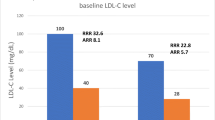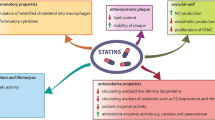Opinion statement
Appropriate management of lipids is a central component of risk reduction in patients with coronary artery disease (CAD). According to the most recent guidelines, low-density lipoprotein cholesterol (LDLC) is the principal target of lipid-lowering therapy and 3-hydroxy-3-methylglutaryl coenzyme A reductase inhibitors (statins) are the mainstay of this therapy. The actual target level of LDL lowering is being reassessed in light of recent clinical trials. Once appropriate LDL lowering has been achieved, treatment of other targets such as high-density lipoprotein cholesterol (HDLC), triglycerides, and non-HDLC should be considered. In addition to dyslipidemia, multiple observational studies suggest that inflammatory markers such as C-reactive protein (CRP) are associated with risk of cardiovascular events and that treatment with statins may lower CRP levels. However, there are insufficient data at this time supporting treatment of CRP as a principal target in CAD.
Similar content being viewed by others
References and Recommended Reading
Smith SC Jr, Allen J, Blair SN, et al.: AHA/ACC guidelines for secondary prevention for patients with coronary and other atherosclerotic vascular disease: 2006 update endorsed by the National Heart, Lung, and Blood Institute. J Am Coll Cardiol 2006, 47:2130–2139.
Heart Protection Study Collaborative Group: MRC/BHF Heart Protection Study of cholesterol lowering with simvastatin in 20,536 high-risk individuals: a randomised placebo-controlled trial. Lancet 2002, 360:7–22.
Cannon CP, Braunwald E, McCabe CH, et al.: Intensive versus moderate lipid lowering with statins after acute coronary syndromes. N Engl J Med 2004, 350:1495–1504.
Scirica BM, Morrow DA: Is C-reactive protein an innocent bystander or proatherogenic culprit? The verdict is still out. Circulation 2006, 113:2128–2134; discussion 2151.
Ridker PM, Cannon CP, Morrow D, et al.: C-reactive protein levels and outcomes after statin therapy. N Engl J Med 2005, 352:20–28.
Nissen SE, Tuzcu EM, Schoenhagen P, et al.: Statin therapy, LDL cholesterol, C-reactive protein, and coronary artery disease. N Engl J Med 2005, 352:29–38.
Rosenson RS, Koenig W: Utility of inflammatory markers in the management of coronary artery disease. Am J Cardiol 2003, 92:10i–18i.
Kris-Etherton PM, Harris WS, Appel LJ: Fish consumption, fish oil, omega-3 fatty acids, and cardiovascular disease. Circulation 2002, 106:2747–2757.
Jenkins DJ, Kendall CW, Marchie A, et al.: Effects of a dietary portfolio of cholesterol-lowering foods vs lovastatin on serum lipids and C-reactive protein. JAMA 2003, 290:502–510.
Sacks FM: The role of high-density lipoprotein (HDL) cholesterol in the prevention and treatment of coronary heart disease: expert group recommendations. Am J Cardiol 2002, 90:139–143.
Third Report of the National Cholesterol Education Program (NCEP) Expert Panel on Detection, Evaluation, and Treatment of High Blood Cholesterol in Adults (Adult Treatment Panel III) final report [no authors listed]. Circulation 2002, 106:3143–3421.
Grundy SM, Cleeman JI, Merz CN, et al.: Implications of recent clinical trials for the National Cholesterol Education Program Adult Treatment Panel III guidelines. Circulation 2004, 110:227–239.
Shepherd J, Blauw GJ, Murphy MB, et al.: Pravastatin in elderly individuals at risk of vascular disease (PROSPER): a randomised controlled trial. Lancet 2002, 360:1623–1630.
Schwartz GG, Olsson AG, Ezekowitz MD, et al.: Effects of atorvastatin on early recurrent ischemic events in acute coronary syndromes: the MIRACL study: a randomized controlled trial. JAMA 2001, 285:1711–1718.
Cohen JC, Boerwinkle E, Mosley TH Jr, Hobbs HH: Sequence variations in PCSK9, low LDL, and protection against coronary heart disease. N Engl J Med 2006, 354:1264–1272.
Davidson MH, McGarry T, Bettis R, et al.: Ezetimibe coadministered with simvastatin in patients with primary hypercholesterolemia. J Am Coll Cardiol 2002, 40:2125–2134.
Ballantyne CM, Houri J, Notarbartolo A, et al.: Effect of ezetimibe coadministered with atorvastatin in 628 patients with primary hypercholesterolemia: a prospective, randomized, double-blind trial. Circulation 2003, 107:2409–2415.
Rubins HB, Robins SJ, Collins D, et al.: Gemfibrozil for the secondary prevention of coronary heart disease in men with low levels of high-density lipoprotein cholesterol. Veterans Affairs High-Density Lipoprotein Cholesterol Intervention Trial Study Group. N Engl J Med 1999, 341:410–418.
Robins SJ, Collins D, Wittes JT, et al.: Relation of gemfibrozil treatment and lipid levels with major coronary events: VA-HIT: a randomized controlled trial. JAMA 2001, 285:1585–1591.
Gotto AM Jr: High-density lipoprotein cholesterol and triglycerides as therapeutic targets for preventing and treating coronary artery disease. Am Heart J 2002, 144:S33–S42.
Toth PP: High-density lipoprotein as a therapeutic target: clinical evidence and treatment strategies. Am J Cardiol 2005, 96:50K–58K; discussion 34K–35K.
Brown BG, Zhao XQ, Chait A, et al.: Simvastatin and niacin, antioxidant vitamins, or the combination for the prevention of coronary disease. N Engl J Med 2001, 345:1583–1592.
Pieper JA: Overview of niacin formulations: differences in pharmacokinetics, efficacy, and safety. Am J Health Syst Pharm 2003, 60:S9–S14; quiz S25.
Kashyap ML, McGovern ME, Berra K, et al.: Long-term safety and efficacy of a once-daily niacin/lovastatin formulation for patients with dyslipidemia. Am J Cardiol 2002, 89:672–378.
Sidhu JS, Cowan D, Kaski JC: The effects of rosiglitazone, a peroxisome proliferator-activated receptor-gamma agonist, on markers of endothelial cell activation, C-reactive protein, and fibrinogen levels in non-diabetic coronary artery disease patients. J Am Coll Cardiol 2003, 42:1757–1763.
Author information
Authors and Affiliations
Corresponding author
Rights and permissions
About this article
Cite this article
Mishra, R.K., Basson, C.T. Treatment goals for the management of lipids and inflammation for patients with coronary artery disease. Curr Treat Options Cardio Med 9, 3–10 (2007). https://doi.org/10.1007/s11936-007-0046-x
Published:
Issue Date:
DOI: https://doi.org/10.1007/s11936-007-0046-x




